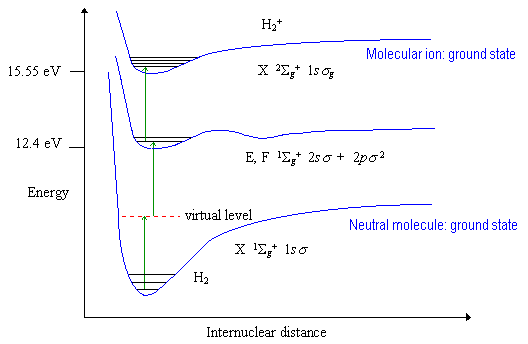|
| |
Laser SystemsThe principal ionisation source of the experiment is a pulsed UV laser. By tuning the laser wavelength to the energy of a particular rovibronic state, the population of molecules formed in that state can be probed. The first ionisation energy of H2 is at 15.55 eV. The easiest way to achieve this energy is by using Resonance Enhanced Multiphoton Ionisation or REMPI [1]. Due to the uncertainty principle it is possible to excite a molecule for a short time to an energy level which is not usually available, i.e. a virtual level. REMPI uses two or more photons to excite and ionise molecules from rovibrational levels through the use of these virtual levels. The virtual levels are very short lived ( ~ 10 - 15 s) and if the molecule is not to return to the ground state, the laser intensity must be high enough for two or more photons to be absorbed within the lifetime of the virtual level.
By tuning the laser wavelength, it is possible to ionise molecules from selected energy levels. In the case of molecular hydrogen, we will be using a REMPI process which involves the absorption of two photons (via a virtual level) into a bound rovibrational level of the E,F electronic states from the ground state. A third photon will then be absorbed from the E,F state to ionise the molecule. This process is an example of 2 + 1 REMPI, and all three photons will be of the same wavelength (~202 nm for H2 ). The laser system used in the cosmic dust experiment is a tuneable dye laser. It consists of a dye laser pumped by an Nd:YAG laser. The YAG laser gives ~ 400 mJ pulses at 1064 nm at a rate of 10 Hz. Each pulse has a duration of ~4 ns. These pulses are frequency doubled as they leave the YAG laser, creating photons in the green part of the visible spectrum (532 nm). The pulsed beam is then directed to a unit which removes the infra-red part of the beam which is not required. The green beam then enters the dye laser. The wavelength at which the dye laser outputs can be tuned by changing the dyes used, and fine tuned by changing the position of the optics inside. The optics are driven mechanically and controlled by computer. This allows wavelengths to be selected to a precision of 10 - 12 m. When the beam leaves the dye laser, it enters a frequency tripling unit. This unit has optics which add together two of the dye laser photons, effectively doubling their frequency. These frequency doubled photons are then added to another dye laser photon, effectively tripling their frequency. These frequency tripled photons now have wavelengths in the UV region (~200 nm). The doubling and tripling processes are not 100% efficient, so a reduced dye beam and a frequency doubled beam (in the blue part of the visible spectrum) leave the laser with the UV beam; they are spatially separated by a prism. The UV beam is focused into the reaction chamber via a lens through a quartz window. The focused spot, aimed just above the dust grain target, is suitably intense to allow REMPI. The laser system is capable of producing UV photons at wavelengths as low as 190 nm at ~3 mJ per pulse, suitable for ionising H2 from a variety of rovibrational states. The layout of the laser system is shown below:
References
This page last modified 26 October, 2007 by John Edridge |


